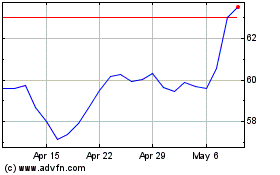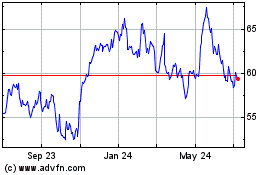By Dylan Tokar
For many multinational companies, preventing bribery and
corruption involves sending lawyers to far-flung places, holding
meetings and web-based surveys, and interviewing uncooperative or
uninformed employees.
It's a human process, prone to bias and error. That is why it's
ripe for a more data-driven approach, experts say.
The company that appears to be ahead in solving this
technological riddle isn't in the tech sector. In fact, its main
product -- beer -- predates the invention of the wheel.
Anheuser-Busch InBev SA, the world's largest brewer, has spent
three years developing machine-learning technology that can
identify risky business partners and potentially illegal payments.
The analytics platform, BrewRight, draws on data from operations in
more than 50 countries, allowing the company to proactively monitor
legal risks and prevent violations, instead of focusing on
investigating problems after they arise.
The platform is designed to get smarter and more effective over
time. It has cut hundreds of thousands of dollars in costs
associated with investigating suspect payments. It has also placed
the company -- the brewer of Budweiser, Stella Artois and other
beers -- at the forefront of corporate anticorruption
compliance.
"They have achieved something I have not seen anyone else
achieve when it comes to integrating their various operational and
financial data," said Hui Chen, an independent consultant who
helped prepare U.S. Justice Department guidance on evaluating
corporate compliance programs and who has seen the platform up
close.
A large company can make millions of payments daily. For most,
accessing data on those transactions can be an expensive and
time-consuming endeavor. But doing so could also be the key to
stopping corruption before it happens. "Once you have the data you
see the pattern and the pattern allows you to be predictive," Ms.
Chen said.
If fully realized, AB InBev's efforts could pave the way for a
new generation of corporate compliance -- one where companies
leverage internal data to create transparency. The approach could
also reshape the expectations of law-enforcement agencies such as
the Justice Department.
Born From a Big Deal
The BrewRight platform had its genesis in one of the biggest
corporate mergers in recent history: AB InBev's purchase of
SABMiller PLC in 2016.
Companies typically examine the compliance practices of acquired
businesses, looking for areas that need stronger safeguards. Such
assessments can involve basic data analysis, but they traditionally
rely heavily on the judgment of lawyers or auditors who are flown
around the world to interview local employees about how the
business works.
That way of vetting acquisitions is widely accepted, but AB
InBev executives felt it was inefficient. The brewer had already
dealt with a bribery investigation by the U.S. Securities and
Exchange Commission into a joint venture in India. The size of the
$100 billion-plus SABMiller deal -- which required the integration
of a compliance program that spanned SAB operations in 25 countries
-- prompted the company to go a step further.
AB InBev's compliance team decided to build a repository where
data from across its various systems accrued. The goal was to
create a tool that was useful inside and outside the compliance
department, according to Matt Galvin, the AB InBev executive who
spearheaded the project.
"The more visibility everyone has into what everyone else is
doing, the more likely they are going to make better decisions,"
said Mr. Galvin, now AB InBev's global vice president for ethics
and compliance. "That to me is the next evolution of the corporate
compliance program."
Today, BrewRight pulls data from more than a dozen enterprise
resource planning systems -- mainly related to accounts payable --
as well as expense, compliance and investigations records, and
external data from sources such as sanctions lists and Transparency
International's Corruption Perceptions Index.
The data passes through models that offer insights into the
business, with a focus on ranking risky transactions and
third-party vendors. The platform allows AB InBev's compliance team
to identify and investigate suspect payments -- sometimes before
they are finalized.
Each transaction that is cleared or escalated by a member of Mr.
Galvin's team becomes another data point that the platform, using
machine-learning technology, can use to improve its models'
accuracy.
Often, a flagged transaction or vendor can be cleared with a few
phone calls. But if it warrants a more substantive investigation,
the compliance team already has much of the data needed to do so at
their fingertips, which speeds the process and makes investigators
more efficient.
One probe into a certain type of third-party vendor in three
countries cost AB InBev about $1.8 million before BrewRight, Mr.
Galvin said. Replicated with the new platform, another
investigation into the same type of vendor in six countries cost
about $250,000, he said.
Getting Other Companies on Board
Data analytics and artificial intelligence are widely used in
heavily regulated industries, such as the financial sector, to
detect money laundering and fraud. But companies have been slow to
apply advanced technologies to their anticorruption efforts --
despite the steep costs and blockbusters fines associated with
foreign bribery investigations.
Just 22% of roughly 1,000 companies surveyed by the Association
of Certified Fraud Examiners use even rudimentary data analytics to
monitor for bribery and corruption, according to a 2019 report. And
only about 13% of the companies surveyed used artificial
intelligence or machine learning to fight fraud.
Historically, companies have focused on investigating misconduct
after it occurs. "Data analytics and what AB InBev has done changes
that equation," said Eugene Soltes, a Harvard Business School
professor who wrote a case study on AB InBev's compliance efforts.
"They want to put much more on the front-end -- on prevention and
detection."
Other companies, including Microsoft Corp. and Walmart Inc.,
which have faced their own foreign bribery probes, have built
analytics tools to deal with risky areas of their businesses. But
the scope and ambition of AB InBev's platform -- which has been
designed to do everything from help prevent money laundering and
antitrust violations to catch duplicative payments and track beer
giveaways -- sets the brewer apart.
Mr. Galvin said he doesn't want BrewRight to be a trade secret.
He speaks regularly about the project at conferences and gives
demos to fellow compliance officers. He wants to develop a
consortium that enables companies to share insights from their data
to boost the accuracy of their analytics models.
The upfront cost of creating a similar tool could deter many
smaller companies, but Mr. Galvin said he hopes AB InBev's
experience to serve as a guidepost, potentially lowering the price
tag.
"Compliance systems aren't data-driven like they should be
because they have been traditionally run by attorneys," said
Vincent Walden, a managing director at professional-services firm
Alvarez & Marsal Holdings LLC who was hired by AB InBev to help
launch BrewRight while a partner at Ernst & Young. "Legal and
compliance departments have been sheltered for years by procedures
and words."
Government Is Watching
That may change as one of the primary drivers of anticorruption
compliance -- the Justice Department -- takes notice of projects
like AB InBev's.
Prosecutors also have been investing in analytics tools that
allow them to spot fraud in Medicare claims or securities markets,
then-Deputy Assistant Attorney General Matthew Miner said at a
conference in Washington in September. Mr. Miner, who recently left
the agency, oversaw investigations into violations of the U.S.
Foreign Corrupt Practices Act, which prohibits bribes paid to
foreign government officials.
"If misconduct does occur," he said, "our prosecutors are going
to ask how, if at all, the company's compliance program is making
use of its own data resources."
Write to Dylan Tokar at dylan.tokar@wsj.com
(END) Dow Jones Newswires
January 17, 2020 05:44 ET (10:44 GMT)
Copyright (c) 2020 Dow Jones & Company, Inc.
Anheuser Busch Inbev SA NV (NYSE:BUD)
Historical Stock Chart
From Mar 2024 to Apr 2024

Anheuser Busch Inbev SA NV (NYSE:BUD)
Historical Stock Chart
From Apr 2023 to Apr 2024
